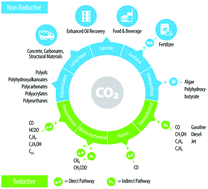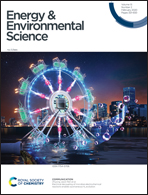Transforming the carbon economy: challenges and opportunities in the convergence of low-cost electricity and reductive CO2 utilization†
Abstract
The increasing availability of renewable electricity at costs competitive with, and even lower than, electricity from fossil sources along with growing interest and recent technological advancements in reducing carbon emissions through CO2 capture is challenging the status quo in the way that we produce and consume energy and products. Renewable electricity can be leveraged to produce fuels and chemicals from CO2, offering sustainable routes to reduce the carbon intensity of our energy and products-driven economy. A number of approaches have been developed for the electron-driven reduction of CO2 to products, including both direct and indirect (via an energy carrier such as H2) pathways and spanning from electrochemical to biological to thermocatalytic conversion. While these approaches are at various stages of development, there are technical barriers related to each core conversion technology that need to be addressed in order to accelerate commercialization and drive the transition towards a circular carbon economy. In this perspective, we assess and characterize the top technical barriers for utilizing renewable electricity for CO2 reduction across five different conversion approaches (direct electrochemical, direct bioelectrochemical, direct non-thermal plasma, indirect bioelectrochemical, and indirect thermochemical) under state-of-technology conditions, outline the R&D needs to overcome each barrier, and identify the most promising C1–C3 hydrocarbons and oxygenates based on their relative ease of formation, economic viability, CO2 utilization potential, and energy storage capacity. Our analysis suggests, based on current reported states of technology, that indirect pathways paired with the formation of C1 products offer the most technically feasible approach for electron driven CO2 reduction in the near term. However, as we strive for longer carbon chain molecules, and as technologies continue to advance, there are a multitude of advantages and limitations to be considered for all five approaches.

- This article is part of the themed collection: Energy & Environmental Science Cover Art


 Please wait while we load your content...
Please wait while we load your content...